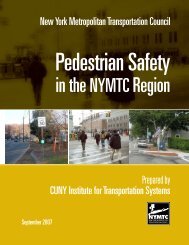Chapter 3 The Transportation System - New York Metropolitan ...
Chapter 3 The Transportation System - New York Metropolitan ...
Chapter 3 The Transportation System - New York Metropolitan ...
- No tags were found...
Create successful ePaper yourself
Turn your PDF publications into a flip-book with our unique Google optimized e-Paper software.
<strong>Chapter</strong> 3Table 3.12Functional Classification Codes NYS Codes Urban NYS Codes Rural FHWA CodesPrincipal Arterial ‐ Interstate 11 1 1Principal Arterial ‐ Other Freeway/Expressway 12 2 2Principal Arterial ‐ Other 14 4 3Minor Arterial 16 6 4Major Collector 17 7 5Minor Collector 18 8 6Local 19 9 7<strong>The</strong>se major highways are vital to the region’seconomy, providing access to bothraw material producers and finishedgoods suppliers across the nation. Interstatehighways also link the NYMTCregion to foreign trading partners inCanada, Mexico, and the Pacific Rim(via West Coast ports). On a regionalscale, these Interstate highways combinewith 14 expressways and 36 parkways tosupport regional automobile and trucktravel, including commuter trips by carand bus, shopping and recreational trips,business-related trips, and distributionof freight and consumer goods by trucksand delivery vans. High OccupancyVehicle (HOV) lanes in the NYMTCDynamic message sign in Suffolk County.region such as along I-278 in Staten Islandand Brooklyn offer carpoolers traveltime savings and help improve regionalair quality by incentivizing a reductionin single-occupancy vehicles. A comprehensivelocal street network serves as thefinal link in long-distance and regionaltrips while supporting local travel bybuses, trucks, bicycles, taxis, and privateautomobiles. I-287 has been undergoinga 10-year update by NYSDOT. Localtraffic is being separated from highwaytraffic by means of service roads parallelingthe highway, and exits 8 and 8E arealso being reconfigured to improve trafficflow.<strong>New</strong> signs have been installed on theLong Island Expressway (LIE) informingdrivers of the estimated time it takes toget to the next exit, and whether or notto expect delays. <strong>The</strong> signs were addedto 19 locations on the expressway. Meanwhile,a seven-mile stretch of the road betweenexits 35 and 41 averages between169,000 and 222,000 drivers per dayand, as a result, requires improved lighting,increased pull-off areas, and betterconditions for police officers. Portionsof the LIE within Suffolk County willalso see the addition of steel cable barrierssuch as those being installed on an11-mile stretch in Brookhaven. <strong>The</strong> townof Riverhead will receive them by 2015.<strong>New</strong> <strong>York</strong> City received federal TIGERfunds to study the 1.3-mile Sheridan Expresswayin the Bronx. <strong>The</strong> multi-agencyeffort involves working with residents,elected officials, and area businesses todevelop recommendations for a moreviable relationship between vehicular accessand the needs of the surroundingcommunity. Results from the study willfeed into NYSDOT’s study of the stateownedexpressway. In addition to analyzingthe transportation network, <strong>New</strong><strong>York</strong> City’s study looks at potential landuse development in the area. <strong>The</strong> goalof <strong>New</strong> <strong>York</strong> City’s study is to chart a wayforward with <strong>New</strong> <strong>York</strong> State that willbalance the needs for community infrastructure,revitalization and open spacewith those for better commercial vehicleaccess and improved infrastructure forthe Hunts Point Market and other businesses.BRIDGESMillions of vehicles per day within theNYMTC region travel on bridges, rangingfrom small crossings to larger bridgessuch as Tappan Zee Bridge, which connectsRockland and Westchester counties.None of the bridges in the 10-countyregion are rated among the worst inthe country. Suffolk, Richmond andNassau counties maintain the lowest percentageof deficient bridges in the state,while the Bronx has the highest in theregion (18.5 percent).Bringing both I-87 and I-287 over theHudson River, the Tappan Zee Bridge isan important link on the <strong>New</strong> <strong>York</strong> StateThruway system. However, the bridgecarries more traffic now than was expectedwhen it was first built, while maintenanceis becoming costly. To remedythese increasing costs, the bridge replacementwas nominated for an expeditedfederal environmental review in 2011.Construction of the replacement bridgecould start as soon as 2013 and will takeabout 4 years to complete.<strong>The</strong> <strong>Transportation</strong> <strong>System</strong> 3-31
















